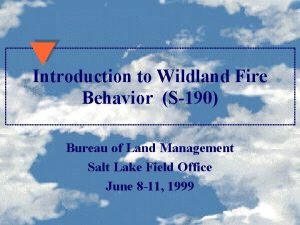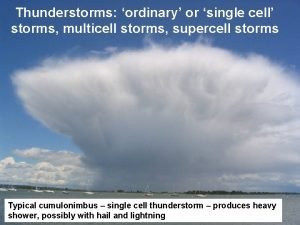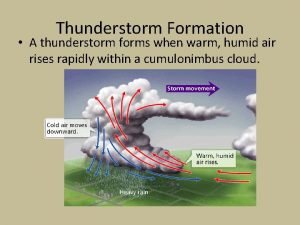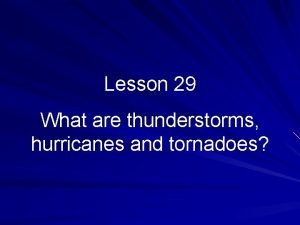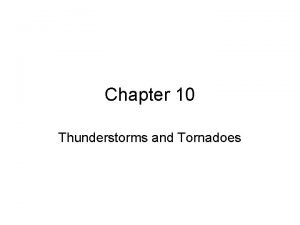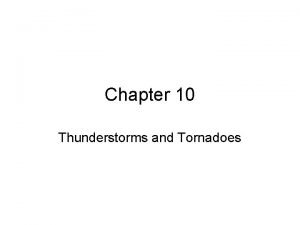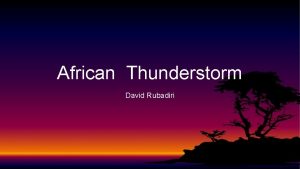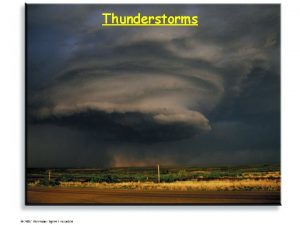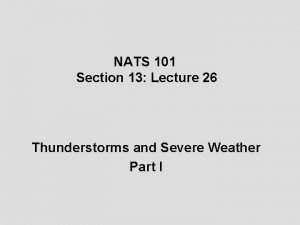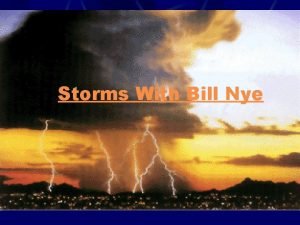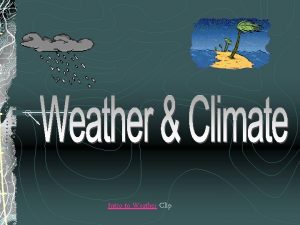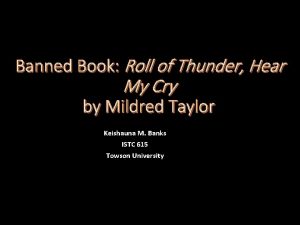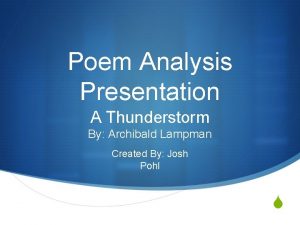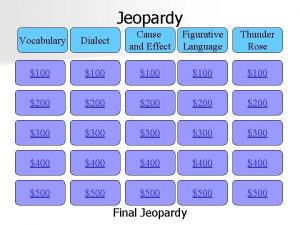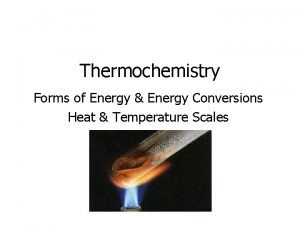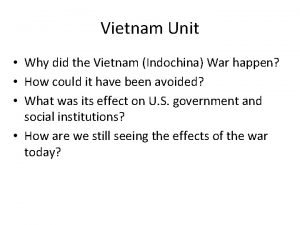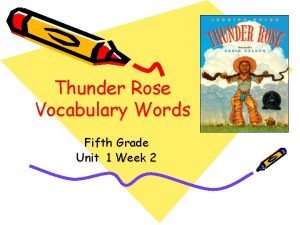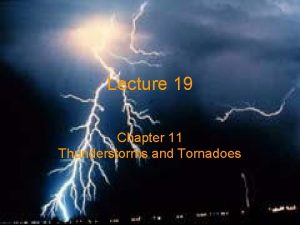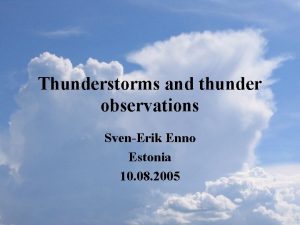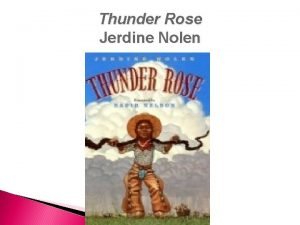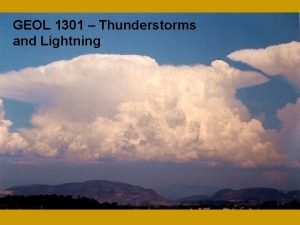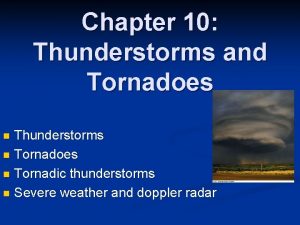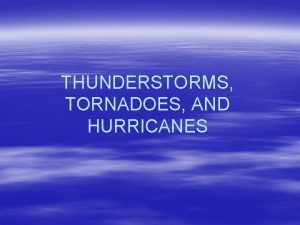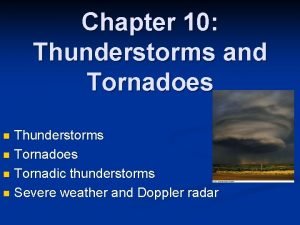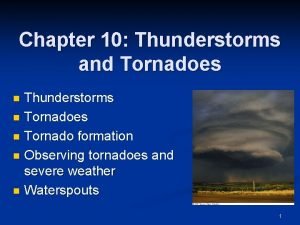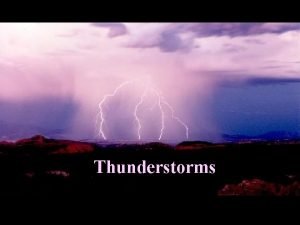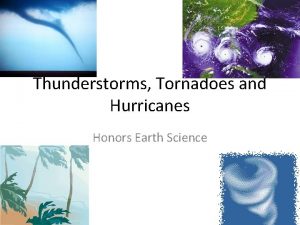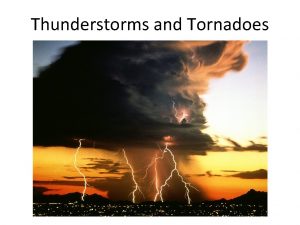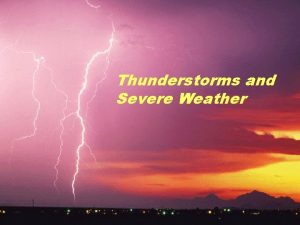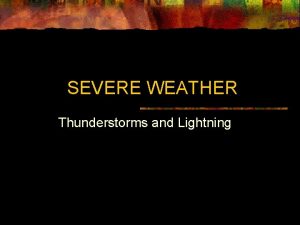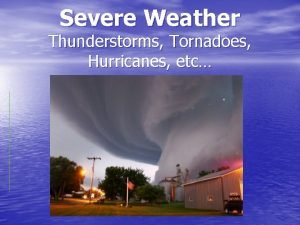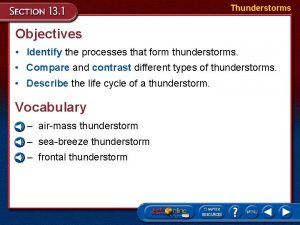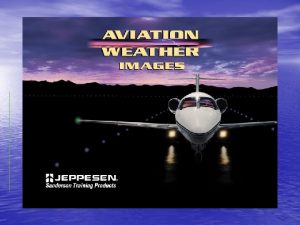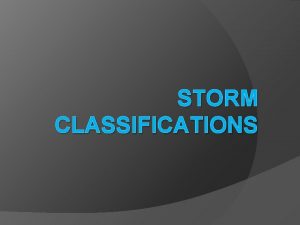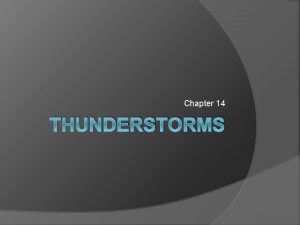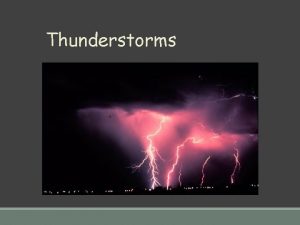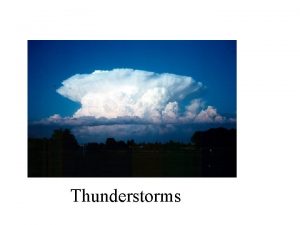Lecture 17 Thunderstorms Supercells Intro to Thunder and































- Slides: 31

Lecture 17 Thunderstorms & Supercells, Intro to Thunder and Lightning

Learning Goals for Part 1 of Chapter 10 1. Be able to describe what a THUNDERSTORM is and the general stages of growth for an AIRMASS THUNDERSTORM. 2. Be able to describe what a SEVERE THUNDERSTORM is (how it differs from a regular one) and be able to identify specific parts of a SUPERCELL THUNDERSTORM. 3. Be able to describe what LIGHTNING is and how it occurs, also be able to describe what THUNDER is and how it is related to lightning. 2

Thunderstorm Introduction • • • A storm that generates lightning and thunder. lightning thunder Are characterized by strong “up” and “down” motions Frequently produces gusty winds, heavy rain and hail They can form on their own or they can form in own conjunction with mid-latitude cyclone on the edge of a Cold-Front They can form in conjunction with hurricanes Locations in the continental US – – Florida has the most thunderstorms (100 s per year) Florida Commonly occur in the foothills of the Rocky Mountains Associated with Tornado Alley in the middle of the country Associated with drylines and air with different humidities drylines

Thunderstorm Formation Introduction • Form when warm, humid air rises in a conditionally unstable or unstable environment • There are two categories: 1. Air Mass Thunderstorms – formed by unequal heating of the Earth’s surface within a maritime tropical (m. T) air mass. 2. Severe Thunderstorms – formed by unequal heating & lifting of warm air along a front or mountain.

Air Mass Thunderstorms • • • Happens inside an air mass (usually m. T) m. T Usually in spring and summer spring summer Usually in mid-afternoon Not associated with a front Due to local differences in temperature

Air Mass Thunderstorm Life Cycle • Like mid-latitude cyclones T-Storms have a “Life Cycle” Cycle • Stages of Development – Stage 1: Cumulus Stage – Stage 2: Mature Stage – Stage 3: Dissipating Stage

Air Mass Thunderstorm Life Cycle Stage 1 Stage 2 Stage 3

Stage 1: The Cumulus Stage • Rising air only • Makes a cloud • Cloud gets bigger and bigger • Moisture is being added to higher and higher altitudes • Needs a continuous supply of moisture to survive

Stage 2: The Mature Stage • Precipitation forms – • Rain begins to fall Rain – • Associated with the downdraft (air going down) Most active stage active – • Mainly by the Bergeron Process Gusty winds, lightning, heavy rain, hail Updrafts and downdrafts exist side by side

Stage 2: The Mature Stage • Downdrafts form for two reasons – Entrainment – mixing of dry air with cloud air at the edge of the cloud • • • – Causes the cloud drops to evaporate Energy from evaporation comes from the temperature of the air parcel By evaporating drops, you use up the energy and end up cooling the air parcel Temperature drops, parcel cools Cooler air sinks to the surface Drag – Air is dragged downwards as precipitation falls.

Stage 3: Dissipating Stage • Cooling effect of falling precipitation and influx of colder air up top mark it’s END! • Downdraft cuts off updraft Downdraft • Cloud stops growing • You’re left with weakly descending air parcels • The cloud basically KILLS itself

Severe Thunderstorms • Heavy downpours, flooding, gusty straight-line winds, large hail, lightning and tornadoes! • NOT Common on the Hawaiian and Pacific Islands. • To be classified as Severe: Severe – – – Must have winds in excess of 93 km/h or 58 mph or hail 0. 75 inches or a confirmed tornado

Severe Thunderstorm

Severe Thunderstorm Overshooting Top • Persist for many hours – – • Anvil Vertical wind sheer causes precipitation to fall in downdraft, allowing the updraft to retain strength. Sometimes the updraft is so strong you get overshooting tops and anvils! anvils Cold air of the downdrafts spread out making: – – “mini cold front” Called a GUST FRONT Called an Outflow Boundary Can form a Roll Cloud

Supercell Thunderstorm • • • Causes dangerous weather Large, very powerful, up to 20 km in height Last many hours 20 -50 km in diameter Vertical wind profile may cause the updraft to ROTATE! – MESOCYCLONE – usually spawns Tornadoes! • Need a lot of Latent Heat – – – Requires moist troposphere An inversion a couple of km above the surface (caps moisture) Unstable air can break through the inversion by “eroding” it

Supercell Diagram

Lightning and Thunder • Lightning is ulia in Hawaiian ulia • Thunder is hekili in Hawaiian hekili • A storm is classified as a thunderstorm only after thunder is heard!! thunder – Because thunder is produced by lightning, lightning must also lightning be present! • Lightning is a discharge of electrical energy • Essentially a giant “spark” between regions of positive (+) and negative (-) charge.

Lightning • May occur: – Between cells in the same storm • inter-cloud lightning – Within a cloud • intra-cloud lightning – Cloud to air – Cloud to ground (CG) • Lightning forms when a charge separation occurs in a cloud – The earth is trying to equalize the electrical difference – Negative charges want to flow to the ground.

Lightning Formation – Charge Separation • We don’t exactly know why it happens • One theory: – Hail stones tend to have a warmer surface than ice crystals – When warm hail collides with colder ice, electrons transfer from ice to hail – Hail (-) is bigger and heavier and settles toward the bottom of the cloud – Smaller (+) ice crystals are lofted to the top.

Lightning Formation • Excess electrons cause the air to ionize – Rip molecules apart (N 2 or O 2 become N+, O -…) • Air is normally very INSULATING • Ionized air is very conducting – like a metal wire

Lightning Formation • Ionized air forms tubes of ~50 m in length (150 ft) and 10 cm in diameter ft (4 in) in – Called a LEADER – A bunch of leaders that are connected is called a STEPLEADER NOTE: There still hasn’t been a flash yet!!!

Lightning Formation • Each electron contains LOTS of energy • When it reaches the surface the energy is RELEASED • This energy is RELEASED as HEAT!! HEAT • Electrons are drained at the surface first so the FLASH starts at the ground!!! • Can have several (3 -4) in rapid succession (1/10 of a second apart). (lead by a DART LEADER) LEADER

Lightning Formation • AGAIN: Electrons are drained at the surface first so the FLASH starts at the ground!!! – • This is why lightning is said to GO UP, rather than down UP The movement is STILL from CLOUD to GROUND – But the “heating” happens at the surface FIRST. • The electrons closest to Earth are “discharged” first discharged • Heat that is released causes air around a step-leader to reach 30, 000°C (54, 000°F) – The warmer, the shorter the wavelength 30, 000 K 53, 540. 33 F 8, 000 K 13, 940. 33 F


Lightning Occurrence on the Mainland

Global Lightning Occurrence

Real-time Lightning Websites • World Wide Lightning Location Network – – • http: //wwlln. net/new/map/ Blitzortung. org - Oceana – http: //www. blitzortung. org/Webpages/index. php? l ang=en&page_0=20

Thunder • When air is heated quickly a shockwave forms causes thunder • Similar to planes crossing the sound barrier, firecrackers and gun shots • Sound travels at 330 m/s or 1000 ft/s • If thunder takes 3 seconds to happen after observing lightning then the storm is: – 3 s * 1000 ft/s = 3000 ft away (6/10 of a mile away).

Key Information 1 1. Be able to describe what a THUNDERSTORM is and the general stages of growth for an AIRMASS THUNDERSTORM. • Generates lightning and thunder. • Characterized by strong “up” and “down” motions • Frequently produces gusty winds, heavy rain and hail. • They can form on their own or they can form in conjunction with mid-latitude cyclone on the edge of a Cold-Front • They can form in conjunction with hurricanes • Air Mass Thunderstorms – formed by unequal heating of the Earth’s surface within a maritime tropical (m. T) air mass. ● Rising air only – Makes cloud ● Moisture is being added to higher and higher altitudes ● Needs a continuous supply of moisture to survive ● Both Updrafts and Downdrafts are present, and exist side by side. ● Most active time with heavy rain, hail, and strong winds. ● Downdrafts form for 2 reasons Entrainment – mixing of dry air with cloud air at the edge of the cloud Drag – Air is dragged downwards as precipitation falls. ● Cooling effect of falling precipitation and influx of colder air up top mark it’s END! ● Downdraft cuts off updraft ● Cloud stops growing ● You’re left with weakly descending air parcels ● The cloud basically KILLS itself 29

Key Information 2 2. Be able to describe what a SEVERE THUNDERSTORM is (how it differs from a regular one) and be able to identify specific parts of a SUPERCELL THUNDERSTORM. SEVERE THUNDERTSORMS SUPERCELLS • Heavy downpours, flooding, gusty straight-line winds, large hail, lightning and tornadoes! • Persist for many hours • Vertical wind sheer causes precipitation to fall in downdraft, allowing the updraft to retain strength. • Sometimes the updraft is so strong you get overshooting tops and anvils! • To be classified as Severe: • Winds in excess of 93 km/h or 58 mph • or hail 0. 75 inches • or a confirmed tornado • Cold air of the downdrafts spread out making: • • “mini cold front” Called a GUST FRONT Called an Outflow Boundary Can form a Roll Cloud • Large, very powerful, up to 20 km in height and 20 -50 km in diameter. They last for MANY HOURS. • Vertical wind profile may cause the updraft to ROTATE forming a MESOCYCLOE (which usually spawn TORNADOES). • These storms need a lot of LATENT HEAT, a moist troposphere, and ideally an inversion a couple of km above to surface to cap the moisture.

Key Information 3 3. Be able to describe what LIGHTNING is and how it occurs, also be able to describe what THUNDER is and how it is related to lightning. LIGHTNING • May occur in several different ways. • Between cells in the same storm (inter-cloud lightning) • Within a cloud (intra-cloud lightning) • Cloud to air • Cloud to ground (CG) • Formation – charge separation occurs, STEP-LEADERS ionize the air forming a narrow conductive path to the surface, the bright RETURN STROKE allows negative charge to deposit on the surface (the flash starts at the surface and goes up), a DART-LEADER can re-ionize the conductive path bringing more negative ions down and starting another flash, after several strokes there are no more negative charges. THUNDER • When air is heated quickly a shockwave forms • Similar to planes crossing the sound barrier, firecrackers and gun shots • Sound travels at 330 m/s or 1000 ft/s
 Three visual indicators of lightning and thunderstorms
Three visual indicators of lightning and thunderstorms 01:640:244 lecture notes - lecture 15: plat, idah, farad
01:640:244 lecture notes - lecture 15: plat, idah, farad Parts of a supercell thunderstorm
Parts of a supercell thunderstorm Thunderstorms form when warm, humid air rises in _____.
Thunderstorms form when warm, humid air rises in _____. Clouds, fog, or dew will always form when
Clouds, fog, or dew will always form when What are thunderstorms
What are thunderstorms Bounded weak echo region
Bounded weak echo region Tornado
Tornado Thunderstorms poem
Thunderstorms poem Squall line
Squall line Thunderstorms
Thunderstorms Bill nye storms
Bill nye storms Brainpop weather
Brainpop weather Tropic thunder actor salaries
Tropic thunder actor salaries A sound of thunder cause and effect
A sound of thunder cause and effect Thunder bay and district humane society
Thunder bay and district humane society Doth meaning
Doth meaning Roll of thunder hear my cry over the water bye and bye
Roll of thunder hear my cry over the water bye and bye Poem on thunderstorm
Poem on thunderstorm Thunder rose cause and effect answers
Thunder rose cause and effect answers What causes lightning and thunder
What causes lightning and thunder Conclusion paragraph formula
Conclusion paragraph formula Shakespeare romeo and juliet prologue in modern english
Shakespeare romeo and juliet prologue in modern english Romeo and juliet hook examples
Romeo and juliet hook examples Thermochemistry
Thermochemistry Titles for introductions
Titles for introductions Humane entrepreneurship
Humane entrepreneurship Brainpop precipitation
Brainpop precipitation Operation rolling thunder cold war
Operation rolling thunder cold war Thunder bay to sudbury
Thunder bay to sudbury Thunder rose song
Thunder rose song Operation rolling thunder cold war
Operation rolling thunder cold war
